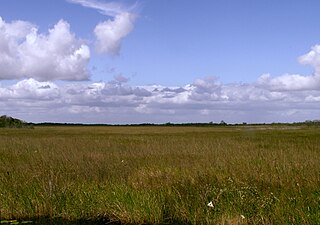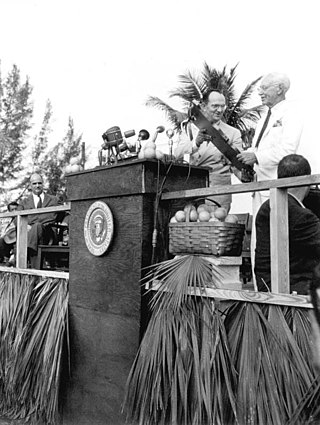
The Everglades is a natural region of tropical wetlands in the southern portion of the U.S. state of Florida, comprising the southern half of a large drainage basin within the Neotropical realm. The system begins near Orlando with the Kissimmee River, which discharges into the vast but shallow Lake Okeechobee. Water leaving the lake in the wet season forms a slow-moving river 60 miles (97 km) wide and over 100 miles (160 km) long, flowing southward across a limestone shelf to Florida Bay at the southern end of the state. The Everglades experiences a wide range of weather patterns, from frequent flooding in the wet season to drought in the dry season. Throughout the 20th century, the Everglades suffered significant loss of habitat and environmental degradation.

Parkland is a suburban city, 42 miles northwest of Miami, in northern Broward County, Florida, United States. As of the 2020 census, the population of Parkland was 34,670. Parkland is part of the Miami metropolitan area, which was home to 6,166,488 people in 2020.

Tamiami is a census-designated place (CDP) in Miami-Dade County, Florida, United States. The population was 54,212 at the 2020 census.

Coconut Grove, also known colloquially as The Grove, is an affluent and the oldest continuously inhabited neighborhood of Miami in Miami-Dade County, Florida. The neighborhood is roughly bounded by North Prospect Drive to the south, LeJeune Road to the west, South Dixie Highway and Rickenbacker Causeway to the north, and Biscayne Bay to the east. It is south of the neighborhoods of Brickell and The Roads and east of Coral Gables. The neighborhood's name has been sometimes spelled "Cocoanut Grove" but the definitive spelling "Coconut Grove" was established when the city was incorporated in 1919.

Flamingo is the southernmost headquarters of Everglades National Park, in Monroe County, Florida, United States. Flamingo is one of the two end points of the 99-mile (159-km) Wilderness Waterway, and the southern end of the only road through the park from Florida City. It began as a small coastal settlement on the eastern end of Cape Sable on the southern tip of the Florida peninsula, facing Florida Bay. The actual town of Flamingo was located approximately 4+1⁄2 miles west of the current Flamingo campground area. All that remains of the former town are a few remnants of building foundations, and it is considered a ghost town.

Everglades National Park is an American national park that protects the southern twenty percent of the original Everglades in Florida. The park is the largest tropical wilderness in the United States and the largest wilderness of any kind east of the Mississippi River. An average of one million people visit the park each year. Everglades is the third-largest national park in the contiguous United States after Death Valley and Yellowstone. UNESCO declared the Everglades & Dry Tortugas Biosphere Reserve in 1976 and listed the park as a World Heritage Site in 1979, and the Ramsar Convention included the park on its list of Wetlands of International Importance in 1987. Everglades is one of only three locations in the world to appear on all three lists.

Marjory Stoneman Douglas was an American journalist, author, women's suffrage advocate, and conservationist known for her staunch defense of the Everglades against efforts to drain it and reclaim land for development. Moving to Miami as a young woman to work for The Miami Herald, she became a freelance writer, producing over one hundred short stories that were published in popular magazines. Her most influential work was the book The Everglades: River of Grass (1947), which redefined the popular conception of the Everglades as a treasured river instead of a worthless swamp. Its impact has been compared to that of Rachel Carson's influential book Silent Spring (1962). Her books, stories, and journalism career brought her influence in Miami, enabling her to advance her causes.

Marjory Stoneman Douglas High School is a public high school in Parkland, Florida, United States. It was established in 1990 and is part of the Broward County Public Schools district. It is named after the writer Marjory Stoneman Douglas and is the only public high school in Parkland, serving almost all of the limits of that city as well as a section of Coral Springs.

The Everglades: River of Grass is a non-fiction book written by Marjory Stoneman Douglas in 1947. Published the same year as the formal opening of Everglades National Park, the book was a call to attention about the degrading quality of life in the Everglades and remains an influential book on nature conservation as well as a reference for information on South Florida. It was used as recently as 2007 by The New York Times.

The Taylor-Grady House, also known as the Henry W. Grady House, is a historic house museum and National Historic Landmark at 634 Prince Avenue in Athens, Georgia, United States. Built in the 1840s, this Greek Revival house is notable as the only known surviving home of Henry W. Grady (1850–89), managing editor of the Atlanta Constitution and a leading force in the reintegration of the American South in the Reconstruction Era that followed the American Civil War. The house is operated by the Junior League of Athens, which offers tours and rentals for private events.

A national push for expansion and progress toward the latter part of the 19th century stimulated interest in draining the Everglades, a region of tropical wetlands in southern Florida, for agricultural use. According to historians, "From the middle of the nineteenth century to the middle of the twentieth century, the United States went through a period in which wetland removal was not questioned. Indeed, it was considered the proper thing to do."

An ongoing effort to remedy damage inflicted during the 20th century on the Everglades, a region of tropical wetlands in southern Florida, is the most expensive and comprehensive environmental repair attempt in history. The degradation of the Everglades became an issue in the United States in the early 1970s after a proposal to construct an airport in the Big Cypress Swamp. Studies indicated the airport would have destroyed the ecosystem in South Florida and Everglades National Park. After decades of destructive practices, both state and federal agencies are looking for ways to balance the needs of the natural environment in South Florida with urban and agricultural centers that have recently and rapidly grown in and near the Everglades.

The David W. Dyer Federal Building and U.S. Courthouse, formerly known simply as the U.S. Post Office and Courthouse, is an historic United States Post Office and federal courthouse of the United States District Court for the Southern District of Florida located at 300 Northeast 1st Avenue in Miami, Florida. Built in 1931 of limestone, it is the largest such structure in South Florida.

Ernest Francis Coe, also "Tom Coe" was an American landscape designer who envisioned a national park dedicated to the preservation of the Everglades, culminating in the establishment of Everglades National Park. Coe was born and spent most of his life in Connecticut as a professional gardener, moving to Miami at age 60. He was enormously impressed with the Everglades and became one of several South Florida-based naturalists who grew concerned for the wanton destruction of plants, animals, and natural water flow in the name of progress and prosperity. Coe worked for more than 20 years to get Everglades National Park established, but he viewed the effort as mostly a failure. However, Oscar L. Chapman, former Secretary of the Interior, stated "Ernest Coe's many years of effective and unselfish efforts to save the Everglades earned him a place among the immortals of the National Park movement."
The Everglades are wetlands in southern Florida, USA.
Joe Bartles Browder was an American environmental activist who spearheaded ongoing efforts to save the Florida Everglades. He was considered to be a global environmental advocate. He was an advisor on energy, climate change, environmental policy to public-interest groups, foundations, auto and energy companies, other businesses, Native American tribes and government agencies. He started out his career as a television news reporter, an active volunteer and later a paid representative for Audubon. No one can be credited more, within a non-political conservation establishment, for the national environmental movement taking the country from the first Earth Day to the election of Jimmy Carter, for whom Browder was an early companion in the early days of Florida primary campaigning
Friends of the Everglades is a conservationist and activist organization in the United States whose mission is to "preserve, protect, and restore the only Everglades in the world." The book Biosphere 2000: Protecting Our Global Environment refers to Friends of the Everglades as an organization that has fought to preserve North America's only subtropical wetland.

The Everglades Wilderness Waterway is a 99-mile navigable recreational waterway route within Everglades National Park, also known as Marjory Stoneman Douglas Wilderness. It includes many interconnecting creeks, rivers, lakes and inner bays that are navigable by shallow draft powerboat, kayak or canoe. The official Wilderness Waterway route is 99 miles long, but a traveler can use various additional route options to greatly extend or slightly shorten the trip.

Roger L. Hammer is a naturalist, botanist, photographer, author, and speaker in Florida. He has written several guides to wildflowers and leads wildflower walks. He met Marjory Stoneman Douglas when he received the Marjory Stoneman Douglas Award.






















